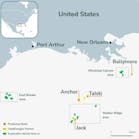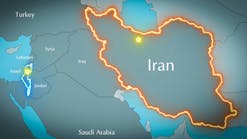California's South Belridge field produced its 1 billionth bbl of oil in May, becoming only the 15th U.S. field to achieve that milestone in 136 years of commercial production in the nation.
Cumulative production to Jan. 1, 1995, was 983.3 million bbl, according to the state's Division of Oil, Gas, and Geothermal Resources, indicating that South Belridge needed 16.7 million bbl more to quality for membership in the exclusive billion-barrel club.
Through the first four months of 1995, the field produced 13.8 million bbl, only 2.9 million bbl short. Figures show the field produced 3.6 million bbl during May, boosting cumulative production to 1,000,700,000 bbl. May production averaged 116,300 b/d.
As a new member of the billion-barrel club, South Belridge joined five other California fields that had attained that milestone, including Kern County's Midway-Sunset, Kern River, and Elk Hills fields, Los Angeles County's Wilmington field, and Orange County's Huntington Beach field.
Other billion-barrel-or-more fields are Alaska's Prudhoe Bay and Kuparuk River; Oklahoma's Sho-Vel-Tum; and Texas's East Texas, Yates, Kelly-Snyder, Slaughter, Wasson, and Panhandle.
Only one other field in the U.S., California's Ventura field, is believed to have the potential to eventually produce 1 billion bbl. To the first of this year, Ventura field had produced 930.2 million bbl and had reserves estimated by the DOGGR of 81.8 million bbl.
'Minor' supergiant
South Belridge field, a 1911 discovery by Belridge Oil Co., had a modest beginning. The 782 ft discovery well produced only 100 b/d from the Diatomite formation. A San Francisco newspaper described the discovery as "a small quantity of oil, not sufficient it is believed to be a commercial success."
Thirteen years later, the field had played such a small role that it was included in an article titled, "The Minor Oil Fields of Kern County," published in the July 1924 issue of the State Mining Bureau's "Summary of Operations-California Oil Fields."
A new era began for the field in the 1960s with the advent of steam injection to increase oil recovery. From an average production of 11,370 b/d at the end of the 1950s, the field by the end of December 1979 was producing 49,500 b/d. In that same month, Shell Oil Co. purchased Belridge Oil Co. for $3.65 billion. The purchase price at the time was the largest corporate merger in U.S. history.
With a major development program by Shell, production peaked in 1987 at 63.8 million bbl, an average of 174,800 b/d. Though decline set in, the field remains a major contributor to the nation's oil output. Production last year was 43.8 million bbl, an average of 120,000 b/d, making South Belridge the fifth most productive oil field in the U.S.
The field's major producers during the first half were CalResources LLC, until the first of this year Shell Western E&P Inc., 57,350 b/d from 2,526 active wells, and Mobil Oil Corp. 47,300 b/d from 714 active wells.
Both are active steamers, with CalResources injecting 150,520 b/d of water converted to steam in 378 steamflood injectors plus 6,900 b/d in cyclic steaming of 30 wells; and Mobil putting away 143,930 b/d in 314 steamflood injectors and 3,500 b/d in cyclic steaming of 15 wells.
Major producing horizons at South Belridge are Tulare sand, which produces 11-14 gravity oil from an average depth of less than 1,000 ft, and Diatomite, which produces 10-34 gravity oil from average depths of 2,000-2,500 ft. The Tulare accounts for 3 of every 4 bbl produced in the field, and the Diatomite for almost all the rest.
South Belridge seems assured of many more productive years. The DOGGR estimates the field's reserves at 387.3 million bbl.
Copyright 1995 Oil & Gas Journal. All Rights Reserved.


